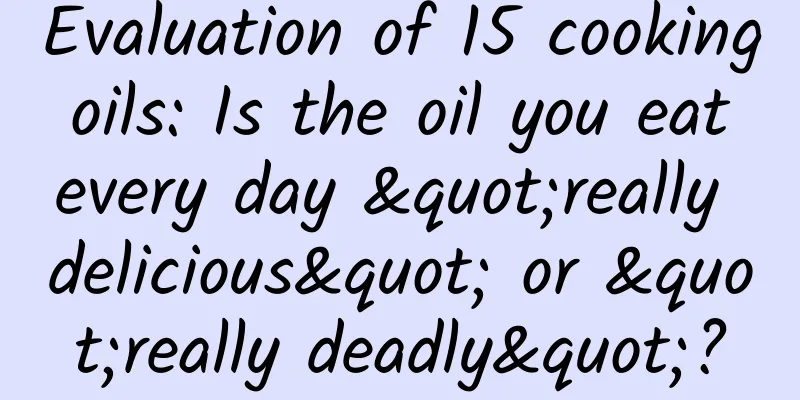Evaluation of 15 cooking oils: Is the oil you eat every day "really delicious" or "really deadly"?

|
God! If you find out that the oil you like is produced in such an environment, can you still eat it? Take a quick look. If the oil you eat at home is pressed in a small workshop and only goes through a simple pressing and filtering process, and the packaging you receive does not even have basic product information or quality grade, then it is most likely - crude oil. In order to test the authenticity of the local oil, we collected samples from the company and major platforms. There are 12 local oils in total, including 6 rapeseed oils and 6 peanut oils. In addition, we also purchased 3 oils produced by regular brands for comparison. The family photo is as follows. Does it look like what you eat at home? After the collection was completed, the technicians packaged the 12 samples of locally pressed oil and sent them to a professional laboratory. Are those natural, earth-pressed oils more nutritious, or are they unclean and carcinogenic? Is that strong aroma real or is there something fishy going on? Let's read on - 01 Oil smoke is very abundant and can cause cancer? It’s true! When cooking in a hot pan, it is inevitable to produce oil smoke. This is because, when the oil temperature in the pot reaches a certain temperature, some substances in the oil will decompose and produce smoke. This lowest temperature is called the smoke point. The lower the smoke point, the easier it is for an oil to produce smoke. We commissioned a lab to test the smoke points of 15 oils. The results are as follows: According to the results, the smoke point of locally pressed oil is generally low, with the smoke point temperature of No. 6 not even exceeding 150°C, while the average smoke point of branded oil is above 210°C. In other words, compared with branded oil, homemade oil will produce more smoke. According to the process, edible oil can be divided into pressed oil and extracted oil. In order to pursue the aroma, most of the oil is simply pressed, which often leads to more impurities in the oil, lower smoke point and more oil smoke. The composition of oil smoke is complex, mainly aldehydes, aromatic compounds, furans and other harmful compounds. The harm of oil smoke to the human body is far more serious than imagined. Research has found that 80% of female lung cancer patients in China do not smoke, but they face a common hazard: cooking fumes. Note: More than 80% of female lung cancer patients are caused by cooking fume. Lung cancer, cancer... These may seem distant and unfamiliar to you, but using unqualified locally pressed oil to cook, even to fry an egg, may put you in a heavily polluted environment. In order to allow everyone to more intuitively compare the PM2.5 produced by heating locally pressed oil and branded oil, we invited professional chefs to do a "fried egg" experiment in a closed experimental cabin. Note: To ensure that the experimental results do not interfere with each other, we will continue with the next experiment after the PM2.5 in the experimental chamber returns to normal. It can be seen that during the process of frying eggs with earth-pressed oil, PM 2.5 soared sharply within 1 minute, once reaching 7 times the severe pollution (0.15 ~ 0.25mg/m³). The higher the PM2.5 value, the more serious the air pollution is and the greater the harm to the body. Severe pollution not only damages the human respiratory system and destroys the immune system, but also greatly increases the risk of recurrence of cardiovascular and cerebrovascular diseases, myocardial infarction, etc. The key point is that we only fried one egg this time. If we use local oil to stir-fry a few more dishes, more oil smoke will accumulate in a short period of time. 02 68 times more toxic than arsenic? Natural hazards are numerous CCTV.com once reported that the unreliable homemade oil pressing had aflatoxin levels that were seriously above the standard. Its toxicity is equivalent to 68 times that of arsenic! The growth of aflatoxin usually means that the food has gone moldy. There are more than 20 aflatoxin derivatives, among which B1 is the most toxic and carcinogenic. To this end, we commissioned a laboratory to test aflatoxin B1 in 15 oils. The results are as follows: According to the "National Food Safety Standard Limits of Mycotoxins in Food", the limit of aflatoxin B1 in peanut oil is 20μg/kg, and the limit of aflatoxin B1 in rapeseed oil is 10μg/kg. Among the 6 types of locally pressed peanut oils tested this time, 4 were found to contain aflatoxin B1, with No. 7 hovering on the edge of exceeding the standard, and No. 9 directly exceeding the standard by nearly 2 times! In fact, aflatoxin itself can easily multiply in grains and oil products. Then why is aflatoxin so rare in commercial oils but so rampant in homemade oils? Compared with the strict raw material screening, refining and factory inspection process of commercial oil, the native oil pressing process only has a few simple steps of "peanut shelling, oil pressing, filtering and sedimentation", which cannot remove aflatoxin. It can be seen that the production environment of crude oil pressing is a simple room, there are still many old stains on the equipment, and the operators don’t even wear gloves. The rough production process and old equipment full of stains are simply a "paradise" for aflatoxin. What’s even worse is that the toxins produced by mold will remain on the processing equipment and be carried into the next batch of oil pressed. 03 Is the earth-pressed oil fragrant? You don't even know it's broken Did you know that oil also has a shelf life? When we were collecting information on homemade oil pressing, we found that many friends did not know when their oil was produced or how long it had been stored. Some of my friends even brought homemade oil from their hometown as "confinement oil" and kept it for more than a year, specifically for consumption during the confinement period. When the technicians were packing some bottles of crude oil, they could clearly smell a strong oily smell, and some of them even had obvious impurities... Are these oils still edible? We tested the peroxide value and acid value of 15 oils: According to GB2716-2018 "National Food Safety Standard Vegetable Oil", the acid value of edible vegetable oil should be ≤ 3 mg/g and the peroxide value should be ≤ 0.25 g/100g. Sure enough, the smell of oily clams was not our imagination. The acid values of No. 1, 5, 6, and 8 not only exceeded the standard, but also exceeded it by multiples. The peroxide value of No. 2 was also not ideal, exceeding the standard by 2 times. This means that the oil has become rancid and spoiled. Don't feel bad about it, just throw it away! Many locally pressed oils look fresh, but are actually difficult to preserve. Unrefined crude oil contains many impurities and is very easy to oxidize. Oxidized oil will produce harmful substances such as polymers, carbonyl groups, and epoxy compounds. As for the "fragrance" of the locally pressed oil that you smell, it is nothing more than the aromatic substances in the unfiltered oil. Apart from the fragrance, it has no other uses. Generally speaking, the shelf life of unopened branded oil is 18 months, and it is recommended to be consumed within 3 months after opening. Due to differences in craftsmanship, the shelf life of locally pressed oil will be even shorter. Therefore, for the oil you eat, be sure to confirm the production date, and don't eat it if it's expired! In addition, improper storage will also cause it to deteriorate and become rancid in advance. It is best to store the oil in a ventilated, cool and dry place. 04 Last words For many people, eating soil and squeezing oil may be a custom passed down from their hometown or a gift from relatives and friends. But when it comes to life and health, whether the oil smells good or not is really secondary. Imagine that every time you use homemade oil, it is like staying in a heavily polluted environment and carefully preparing dishes for your family that are cooked with oil that may become moldy or carcinogenic... Just thinking about it makes me scared. Furthermore, the prices of many locally pressed oils are not cheap, so we recommend choosing regular brands of cooking oil. Putting aside how much better branded oil is than locally pressed oil, at least it has guarantees in terms of production technology and market supervision, so you can eat it with more peace of mind. Just like what this netizen said, since the problem exists, don't take chances. Editor | SuSu Design | Sour References: [1]Mu L, Liu L, Niu R, et al. Indoor air pollution and risk of lung cancer among Chinese female non-smokers[J]. Cancer Causes & Control, 2013, 24(3): 439-450. [2]Wang JB, Jiang Y, Wei WQ, et al. Estimation of cancer incidence and mortality attributable to smoking in China[J]. Cancer Causes & Control, 2010, 21(6): 959-965. [3] Li Chengcheng, Li Yawei, Lu Feng. Meta-analysis of the relationship between exposure to atmospheric particulate matter PM_(2.5) and PM_(10) and mortality from ischemic heart disease in the population[J]. Chinese Journal of Cardiology, 2019, 24(02): 166-172. Dad Review |
>>: Is the fruit and vegetable washing machine just a waste of money?
Recommend
Inventory of plants that are mispronounced | Tamarix and Polygonum multiflorum: The names are too weird, and if you recognize half of them, you are bound to be mispronounced
Many names of trees follow the rules of phono-sem...
Saving money is not as good as saving muscles! Elderly people should be wary of this disease
Tang Dynasty poet Du Fu wrote in "A Hundred ...
Where is the home of 11 million Miao people?
In the mountains of southwest China There is such...
What's the matter with taking watermelon rind to the cafeteria to get food? Why do you take watermelon rinds to the canteen to get food?
Take watermelon rind to the canteen to get food U...
In global navigation, China's Beidou is on par with the US GPS
If Beidou is still just a noun in your eyes After...
9 mysterious maps, how many can you recognize?
Loading long image... Source: National Geographic...
MDSA offline open class will help you decipher high-performance APP development
With the fragmentation of people's demand for...
What will happen if you eat one carrot every day? Will your eyesight really improve? Will your immunity really become stronger?
Carrots are considered a healthy food in everyone...
Universal formula for online event promotion and marketing planning!
In this article, the author will tell you about h...
The leading cause of death among Chinese people is actually this! You need a "healthy diet model" that is more suitable for Chinese people
Recently, the "Guidelines for Blood Lipid Ma...
How much does it cost to make a Zaozhuang takeaway mini program? Zaozhuang takeaway applet production price inquiry
There is no fixed price for the production of Zao...
Five principles for app survival and growth
[[249822]] What do users want most? How to build ...
17 years ago, a comet was "bombarded". This year, there will be another "impact" drama. Saving the Earth is in action
Let me correct one thing first. The so-called &qu...
Alpha Egg Smart Dictionary Pen S Review: Connect to Huawei's smart ecosystem to create the best learning experience
In our primary and secondary school years, dictio...
NAP: Artificial Intelligence and the Future of Work in 2024
In the year since ChatGPT was launched in Novembe...









